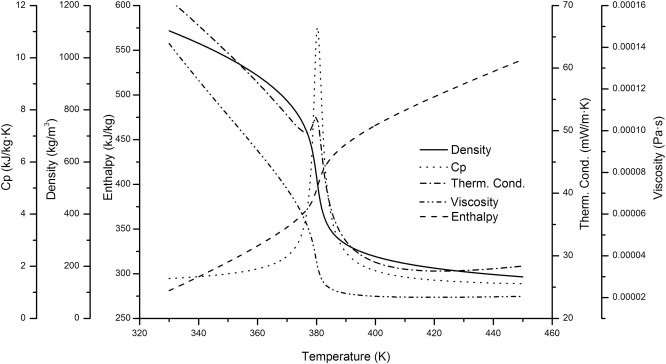当前位置:
X-MOL 学术
›
Int. J. Heat Mass Transf.
›
论文详情
Our official English website, www.x-mol.net, welcomes your
feedback! (Note: you will need to create a separate account there.)
Numerical investigation on heat transfer of the supercritical fluid upward in vertical tube with constant wall temperature
International Journal of Heat and Mass Transfer ( IF 5.0 ) Pub Date : 2019-01-01 , DOI: 10.1016/j.ijheatmasstransfer.2018.09.049 Zheng Yang , Xu Cheng , Xinghua Zheng , Haisheng Chen
International Journal of Heat and Mass Transfer ( IF 5.0 ) Pub Date : 2019-01-01 , DOI: 10.1016/j.ijheatmasstransfer.2018.09.049 Zheng Yang , Xu Cheng , Xinghua Zheng , Haisheng Chen

|
Abstract The supercritical fluid has been extensively applied in many industry applications and heat transfer characteristics of the supercritical fluid play an important role in system safety and economic design. In this paper, heat transfer characteristics and mechanism of the supercritical fluid upward in vertical tube with constant wall temperature are numerically investigated. Heat transfer fluctuation phenomenon is found at the trans-critical section where fluid experiences the pseudo-critical point. Heat transfer fluctuation takes place only when the wall temperature is higher than the pseudo-critical temperature and the bulk temperature is lower than the pseudo-critical temperature. The traditional prediction correlation can’t predict heat transfer fluctuation at the trans-critical section correctly. Heatflux fluctuation is caused by the buoyancy effect. The buoyancy effect induces the periodic flow variation and the periodic convective heat transfer variation on the radial direction, which determine heatflux fluctuation on the wall. The fluctuation amplitude of heatflux on the wall decreases along the axial direction due to the weakened buoyancy effect. Influence of operating conditions on heat transfer of the supercritical fluid is investigated. R134a is chosen as the working fluid. Operating condition includes mass flow ranging from 500 to 800 kg/(m2 s), inlet temperature ranging from 313.15 to 343.15 K, wall temperature ranging from 403.15 to 433.15 K and operating pressure ranging from 4.35 to 5.04 MPa. It is observed that heat transfer coefficient rises with mass flow, wall temperature and operating pressure increasing, but it doesn’t vary obviously with inlet temperature. Fluctuation amplitude of heat transfer coefficient decreases with mass flow, wall temperature, inlet temperature and operating pressure increasing.
中文翻译:

超临界流体在等壁温立管中向上传热的数值研究
摘要 超临界流体在许多工业应用中有着广泛的应用,超临界流体的传热特性在系统安全和经济设计中起着重要作用。本文数值研究了超临界流体在壁温不变的立管中向上的传热特性和机理。在流体经历伪临界点的跨临界段发现传热波动现象。传热波动仅在壁温高于拟临界温度和体温低于拟临界温度时发生。传统的预测关联式不能正确预测跨临界段传热波动。热通量波动是由浮力效应引起的。浮力效应在径向引起周期性流动变化和周期性对流传热变化,这决定了壁上的热通量波动。由于浮力效应减弱,壁面上热通量的波动幅度沿轴向减小。研究了操作条件对超临界流体传热的影响。选用 R134a 作为工作流体。运行条件包括质量流量范围为 500 至 800 kg/(m2 s),入口温度范围为 313.15 至 343.15 K,壁温范围为 403.15 至 433.15 K,运行压力范围为 4.35 至 5.04 MPa。观察到传热系数随着质量流量、壁温和操作压力的增加而增加,但随进口温度变化不明显。传热系数的波动幅度随着质量流量、壁温、入口温度和操作压力的增加而减小。
更新日期:2019-01-01
中文翻译:

超临界流体在等壁温立管中向上传热的数值研究
摘要 超临界流体在许多工业应用中有着广泛的应用,超临界流体的传热特性在系统安全和经济设计中起着重要作用。本文数值研究了超临界流体在壁温不变的立管中向上的传热特性和机理。在流体经历伪临界点的跨临界段发现传热波动现象。传热波动仅在壁温高于拟临界温度和体温低于拟临界温度时发生。传统的预测关联式不能正确预测跨临界段传热波动。热通量波动是由浮力效应引起的。浮力效应在径向引起周期性流动变化和周期性对流传热变化,这决定了壁上的热通量波动。由于浮力效应减弱,壁面上热通量的波动幅度沿轴向减小。研究了操作条件对超临界流体传热的影响。选用 R134a 作为工作流体。运行条件包括质量流量范围为 500 至 800 kg/(m2 s),入口温度范围为 313.15 至 343.15 K,壁温范围为 403.15 至 433.15 K,运行压力范围为 4.35 至 5.04 MPa。观察到传热系数随着质量流量、壁温和操作压力的增加而增加,但随进口温度变化不明显。传热系数的波动幅度随着质量流量、壁温、入口温度和操作压力的增加而减小。







































 京公网安备 11010802027423号
京公网安备 11010802027423号